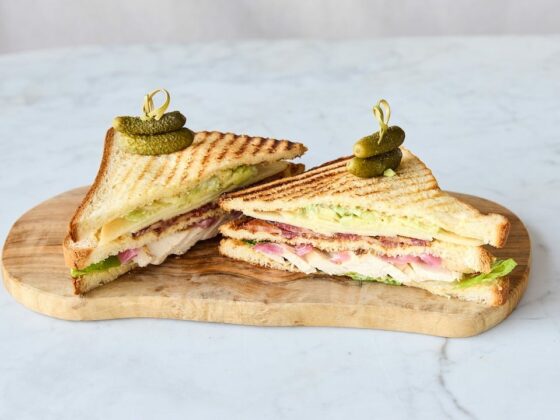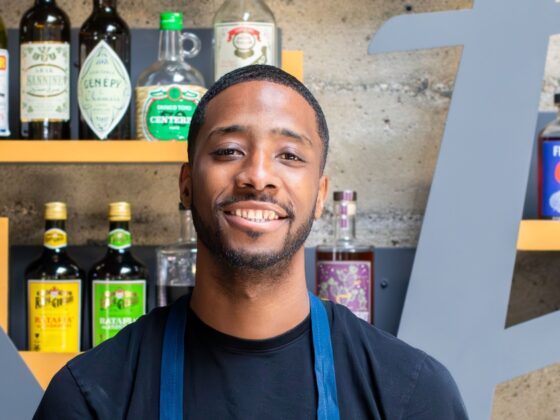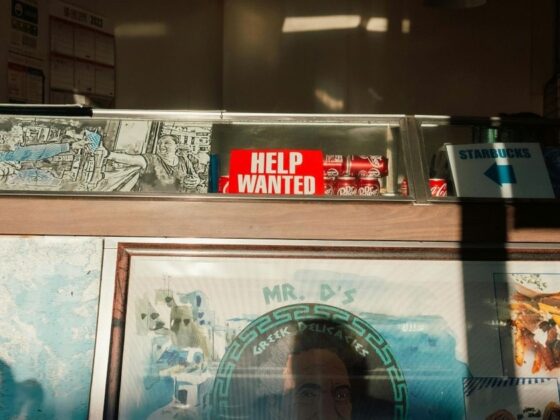There are many things to like about oysters that fit nicely into current food trends. They’re high in protein and a variety of micronutrients, they’re incredibly good for the environment, they’re an affordable luxury, and there are great stories to tell about them.
“You are getting the best possible taste of the sea,” said Bilen Gaga, partner in Selune, a natural wine and oyster bar that just opened in Brooklyn, N.Y., in June. “There are subtle and not-so-subtle differences based on location, but at the core, fresh oysters are just a small way of feeling like you are smelling and tasting the pure essence of the ocean. Don’t they taste like the most perfect day on the beach? I know that’s what they evoke for me.”
They’re certainly growing in popularity: Mentions of oysters on menus have increased by 11.9% over the past year, according to Technomic’s Ignite Menu data.
At Selune the focus is on Utah Beach oysters, named for the bay in France where they grow, which is the same Utah Beach where allied forces landed to liberate Europe during the Second World War. Gaga’s partner, Paris native Marc Lioussane, introduced them to her, saying they were uniquely delicious.
“The first time I had them, I had to begrudgingly agree,” Gaga said.
But transatlantic journeys aren’t necessary for oysters, and many operators focus on what’s harvested from nearby waterways.
The rise of the oyster master
These days most oysters are cultivated. They’re farmed in estuaries or other coastal areas, and they’re not just sustainable — they’re regenerative, cleaning up the waterways where they grow.
“They filter up to 50 gallons of water a day,” said Aaron Juvera, chef de cuisine of Southerleigh Fine Food & Brewery in San Antonio, Texas, and that state’s first certified oyster master.
“One of the farmers we work with has noted that she’s seen the water change visually, and new schools of fish have come back to their bay that they hadn’t seen,” he said in an interview in October.
Oyster certification is new, having just been launched by the Oyster Master Guild in 2023. Although there are four levels of certification on paper, there were only two levels available when Juvera earned his certification and he achieved the first level.
“I thought level one would be like brushing the surface, but they went deep into everything from cultivation history, the species, anatomy, techniques for shucking, impact on the environment. … There are quite a few topics to cover.”
And the Texas oyster industry is new, too. Juvera said the state just started taking applications in 2019 and then licensing was delayed by the pandemic. It takes 18-36 months for oysters to reach market size, around three inches, but Juvera already was using oysters from three farms last year — Copano Creams, Blackjack Point, and Big Tree oysters. He said the Copano Creams grow in brackish water in Copano Bay and have “beautiful umami and a little bit of minerality.” Big Trees grow at the top of the same bay and get more saltwater. “They’re bright, nice, clean, almost a sea bean taste — sort of vegetal,” he said.
And Blackjack Points, from the south side of Aransas Bay, “have a lot more flowing water and are bigger, with a sweeter finish, and a little mineral in there. It’s really interesting that all three of these farms are roughly 40 minutes from each other and are vastly different,” Juvera said.
And they’re also different from typical Gulf of Mexico oysters, which tend to be flabbier and more suited, as far as many chefs and consumers are concerned, to cooking rather than eating raw as Juvera is serving them.
“When I think ‘Gulf oyster,’ I think of the large, rocky guys that some people come in for but others find not so appealing,” Juvera said. The new varieties are so different that the chef has told his staff to call them Texas oysters instead of gulf oysters.
Big Trees are also on the menu at Le Calamar, which opened in Austin in May, serving food inspired by Texas, France, and Mexico.
“I can’t count how many guests have remarked, ‘I didn’t know oysters from the Gulf could be so good!’” chef Casey Wall said in an email.
He has prepared them in a variety of ways, and was particularly pleased with some that he lightly poached in chicken fat, chilled, and then reheated in vermouth cream finished with tarragon oil.
He also served them on the half shell with a mignonette made with green garlic vinegar, pink peppercorns, “tiny onions from Sanchez Family Farms in Poteet, Texas, and the most fragrant dill pollen from Hotspell farms,” he said. “It ends up tasting like the best kosher dill pickle brine you’ve ever had.”
The green garlic in the mignonette also ties into the restaurant’s ethos of minimal waste: The root ends, skins, and fibrous leaves of the garlic are steeped in Champagne vinegar for a couple of weeks, resulting in a “very intensely green garlic flavored vinegar,” he said.
There are five different species of oyster that are widely consumed in the U.S., and four are found on the Pacific Coast, where they tend to be meatier and sweeter than Atlantic oysters, which are all the same species: Crassostrea virginica.
All of them have great nutritional qualities, including high levels of zinc, Vitamin B12, iron, selenium, and Omega-3 fatty acids.
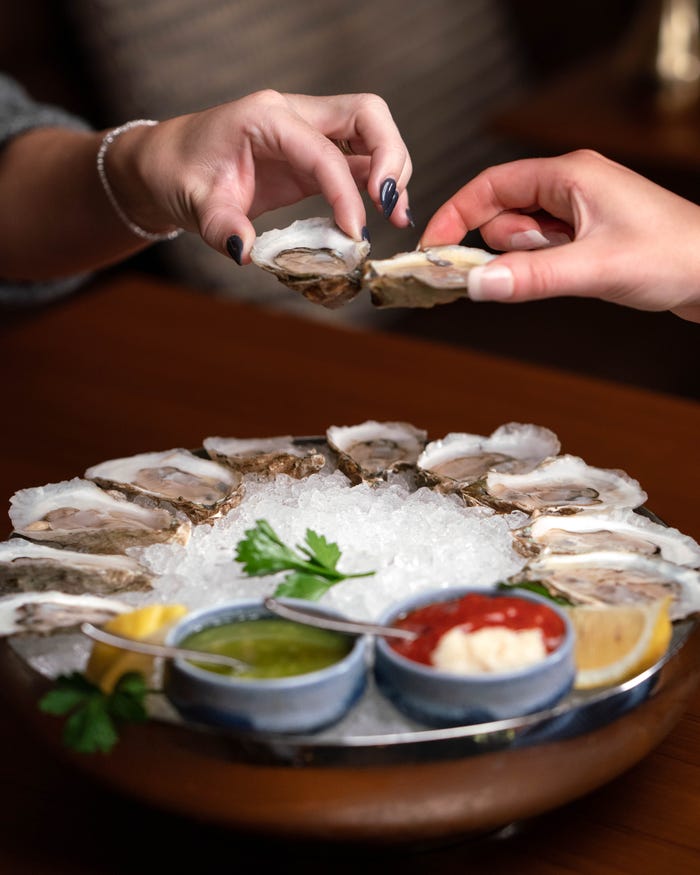
Seamark is one of many restaurants in Boston that offer $1 oysters during happy hour. | Seamark
The appeal of merroir
Even though oysters from Maine to the Caribbean are the same species, they can taste radically different from each other, and the term for that has come to be known as merroir — a play on terroir, which is the French term for the impact that climate, soil, and production techniques have on wine.
Learning that merroir can be a big part of the fun of oyster selection, said Kyle Biddy, executive chef of Little Betty Steak Bar in Mountain Brook, Ala.
“As a chef, I love learning about these specific coastal areas where oysters are grown,” he said in an email. “It gives me something that’s ever-changing for our staff to learn about as we bring in different oysters at different times of the year.”
He mostly uses East Coast oysters from North Carolina to Maine, but also uses Murder Points from Bayou La Batre in Alabama. “They’re actually really good!” he said.
He prepares them in a variety of ways — raw on the half shell with peach verjus and pickled watermelon rind in the summer, roasted with smoked sunchoke foam and pink peppercorn in the fall, and baked with pepper and pecorino cheese, cacio e pepe style, for the holidays. He also serves them raw with his own mignonette of red wine vinegar, red yuzu kosho, fish sauce, lemon, shallot, and black pepper, along with lemon and his house-made hot sauce of lacto-fermented guajillo chiles, Brazilian starfish peppers, morita chile, roasted garlic, and tamari.
“The guest response is fantastic,” he said.
Back in New York City, at Peasant, chef Marc Forgione uses oysters from Widow’s Hole, from the north fork of Long Island, for a dish that reflects the restaurant’s approach to wood-fired cooking.
He starts by roasting bone marrow. “We then treat that like a compound butter and mix with allium, herbs, and red wine,” he said in an email. Then he cools it and spoons it on freshly shucked oysters with a pinch of nduja sausage and roasted them until they’re warmed through and then finish it with a squeeze of lemon juice, serving them on a split marrow bone. “The savory and fatty marrow … and spice from the nduja are perfect compliments to the briny Widow’s Hole oyster,” he said. “They create a perfect surf and turf moment.”
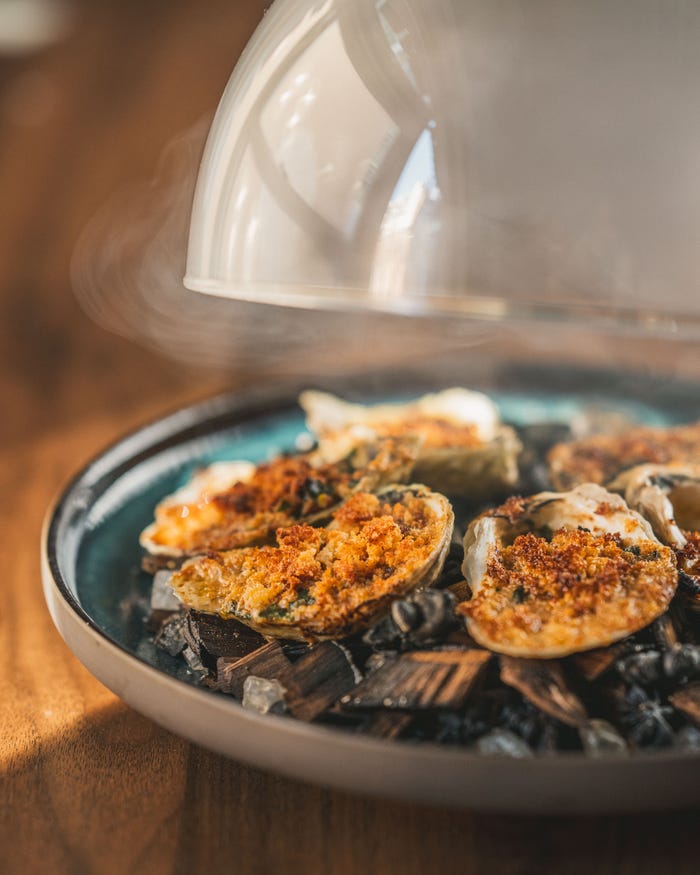
Roasted and smoked oysters from Willow & Ivy in Boston. | Willow & Ivy
Boston’s happy hour substitute
Boston has a unique relationship with oysters. Not only are they prized by locals, and many varieties are grown in the state’s waterways, but many restaurants, including Woods Hill Pier 4, Rebel’s Guild, and Seamark, offer $1 oysters as a substitute for happy hour: Discounting drinks at specific times of day is illegal in Massachusetts, so operators discount oysters instead to draw post-work crowds.
They’re $2 each at The Banks Seafood & Steak.
“We have lots of local businesses and offices in the area and a lot of times people will come in for the oysters,” said chef Robert Sisca. “I personally love the East Coast oysters. I like the briny, strong, punch ’em in the face kind of big, big oyster that you get here.”
So he usually offers three or four varieties of them, particularly local Island Creek and South Bay Blondes, and a rotation of other local varieties to make sure regulars have something new to try, as well as one West Coast oyster.
“They’re a little more creamy, and cucumber,” he said. “It’s just got a little bit different flavor.”
He serves them raw, on the half shell with seasonal mignonette, such as rhubarb in the spring, cucumber in the summer, and apple cider in the fall. Other accompaniments include traditional cocktail sauce and his own house-fermented hot sauce made with Fresno chiles, salt, and pepper. He’ll also offer composed oysters topped with caviar or sea urchin.
Daniel Kenney, executive chef of the Lenox Hotel in Boston, also makes his own hot sauce, which he says is Tabasco-style with Thai and jalapeño peppers as well as a little Basque Espelette. That and a pink peppercorn mignonette and cocktail sauce accompany local raw oysters at the hotel’s signature restaurant, Willow & Ivy, as well as its cocktail bar, the Irving.
But he also roasts them on a bed of rock salt — a classic method that keeps the shellfish level so their liquid doesn’t leak out. He tops them with Irish rashers (salt-cured Irish pork loin), along with shallots, garlic, double cream, Grana Padano cheese, baby spinach, Espelette pepper, and buttery toasted brioche breadcrumbs. The salt is topped with hickory and apple wood chips along with pink and black peppercorns, star anise, clove, and juniper.
“We put them in our really hot pizza oven,” he said, so the wood chips and aromatics smolder. Then he covers them with a glass cloche. The oysters are brought to the table that way for a big, aromatic reveal.
“Roasted at really high temperature, those aromatics really deliver,” he said.
Kenney has worked all over coastal Massachusetts, including Cape Cod and the islands of Martha’s Vineyard and Nantucket, and developed relationships with many of the oyster farmers in the area.
“We stick to those farms,” he said. “It’s a great opportunity for us to use super-fresh oysters. I believe that’s one of the reasons why they’re great.”
Matthew Gaudet also focuses on relationships with oyster farmers. He’s culinary director of Sidell Hospitality, which operates Stephanie’s in Boston as well as Saltie Girl, with locations in Boston and Los Angeles.
The Boston restaurants have five oysters: four local and one from the West Coast.
“At Stephanie’s, we sell them faster than our inventory, so we’re changing them even throughout the day,” he said, noting that front-of-house staff sometimes complains that they have to reprint the menu during the day as suppliers change. “The relationship with the oyster farmers in the region and how it relates to Boston and the audience here suits us well.”
And in Los Angeles, most of the oysters are from the West Coast, but they have one from the East Coast, which suits local preferences. “The people on the West Coast enjoy their West Coast oysters, and the East Coast people enjoy their East Coast oysters,” he said.
But beyond that, he likes to offer a wide variety of different flavors and textures in his oysters.
“When you’re building an oyster program, you have the opportunity to offer different varieties, and you want different textures and sizes,” he said. “Some are more buttery, and some are insanely briny. … You can go for a different journey along the coastline.”
Contact Bret Thorn at [email protected]






